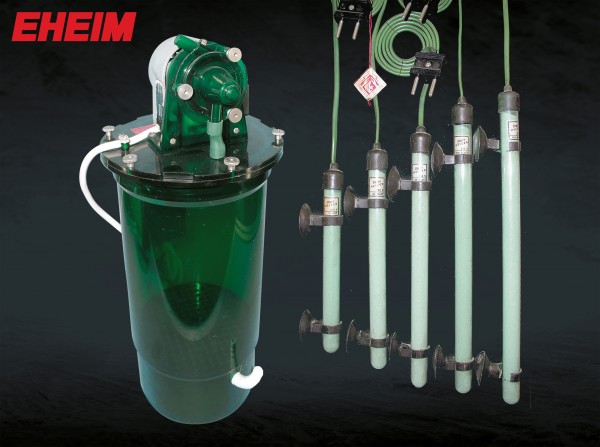Deizisau, december 2023 - To understand the significance of the controller heater and the suction filter for aquatics, you take a look at history: Modern aquatics began with the discovery of oxygen (1774) and the realisation that fish also breathe. But it was not until 1853, after scientists had discovered the importance of carbon dioxide and the interaction between animals and plants in water, that fish were kept in aquariums, i.e., different glass containers. However, the first colourful tropical ornamental fish did not arrive in Europe until 1908. These exotics, however, were demanding in regard to water temperature and water quality. Accordingly, experiments were carried out regarding heating options as well as aeration and filtration equipment.
Invention of the JÄGER controller heater:
Around 1909, aquariums were heated with a brass cylinder, which was heated by a paraffin lamp through a boiling tube. Later, heating became electric. But it was not until 1948, 75 years ago, that engineer Eugen Jäger developed what we think of now as the aquarium heater. Here’s how it came about: Jäger had been producing lighters for wood gas-powered cars since 1946. His son Wolfgang owned a small aquarium. However, their fish died in the cold basement flat where the family lived in bombed-out Stuttgart after the war. Father and son thought about how they could heat up the aquarium water. Finally, they constructed a waterproof heater with a regulator using a filament and test tubes. The first regulator heaters had 10, 15, 20 and 25 watts.
The Jäger regulator heaters quickly became a big seller. As early as 1949, the company moved to a workshop in Stuttgart-Bad Cannstatt. After worldwide demand exceeded capacity there, the Jäger company moved to Wüstenrot (Heilbronn district) in 1967. In 2002, the company was finally sold to EHEIM and from 2012 onwards was managed under the umbrella brand EHEIM. The JÄGER or EHEIM regulator heater has been further developed to this day into a precise electronic temperature control unit and integrated into the "EHEIM Digital family".
Invention of the EHEIM suction filters:
The same applies to oxygen supply and filtration as to heating. Around the turn of the century (1900), a fountain (hand-operated waterfall) provided aeration and a primitive filter operated by a hand pump purified aquarium water. But it was not until the early 1960s that the engineer Gunther Eheim presented the first aquarium suction filter and thus created a revolutionary improvement for aquatics.
The history of EHEIM is like that of JÄGER: in 1949, engineer Gunther Eheim founded his first company in Esslingen near Stuttgart for the "repair and manufacture of technical toys". The business premises were the veranda of his father-in-laws house. Model railways were repaired and rebuilt here. Then in 1953, Eheim introduced a now legendary model trolleybus. This became a hit, and the EHEIM company moved from Esslingen to Deizisau, a few kilometres away. The breakthrough came when designing a fountain for model railway layouts and a waterproof centrifugal pump with magnetic coupling. The idea of combining this special centrifugal pump with a cleaning tank eventually led to the development of the aquarium suction filter. With this, Gunther Eheim thus created the basis for all modern aquatics.
In 1963, 60 years ago, the first EHEIM filter system went into production. By 1971, 100,000 EHEIM aquarium filters were already in use worldwide. Today there are many millions - some of them highly complex, effective devices for small and large aquariums. Including some with advanced digital control and smart networking.
The inventions of Eugen Jäger and Gunther Eheim 75 and 60 years ago respectively have made the ornamental fish aquarium what it is today: a fascinating hobby for many millions of people around the globe. It is astonishing that the two pioneers lived only a few kilometres apart in the Stuttgart region. They were typical Swabian tinkerers and inventors - like Gottlieb Daimler, who also came from here.








